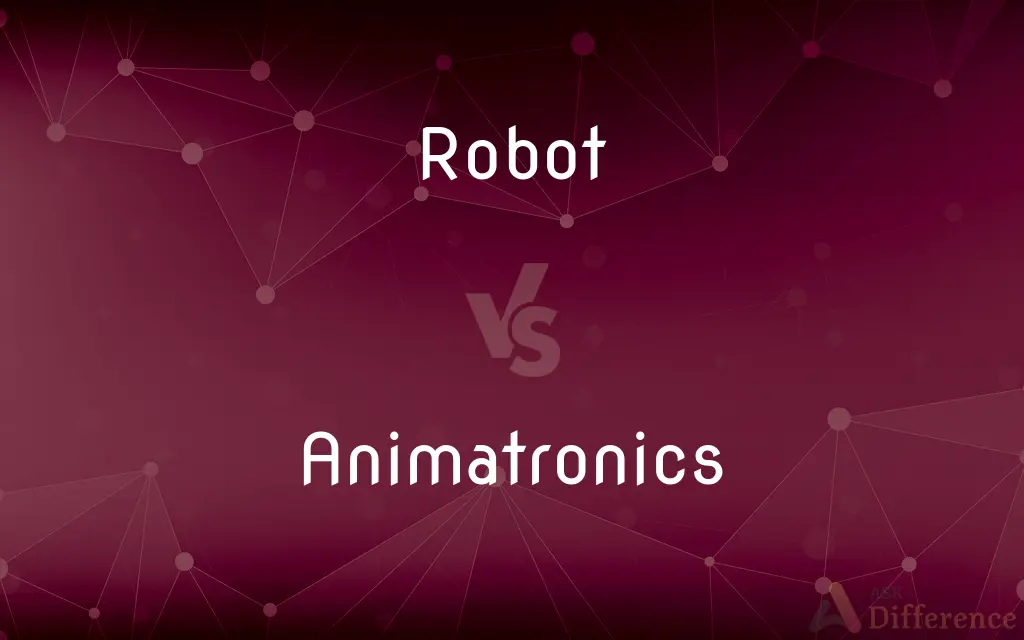Robot vs. Animatronics — What's the Difference?
By Tayyaba Rehman & Urooj Arif — Updated on April 7, 2024
Robots are programmable machines capable of performing a variety of tasks, often with autonomy. Animatronics refers to specialized robots designed to mimic lifelike movements, primarily for entertainment purposes.

Difference Between Robot and Animatronics
Table of Contents
ADVERTISEMENT
Key Differences
Robots, in the broadest sense, are machines equipped with sensors and actuators, programmable to perform a range of tasks, from industrial manufacturing to personal assistance. Whereas animatronics are a subset of robotics, focused on creating lifelike animations in creatures or figures for movies, theme parks, and other entertainment venues.
While robots are celebrated for their efficiency and precision in tasks such as assembly lines, data collection, and surgical procedures, animatronics are engineered for visual and emotional impact, aiming to entertain and enchant audiences. This highlights the functional divergence between the two, with robots optimizing practical applications and animatronics enhancing experiential and entertainment values.
The development of robots emphasizes advancements in AI, machine learning, and autonomy, striving for increased efficiency, adaptability, and independence in operation. On the other hand, the evolution of animatronics focuses on achieving more realistic, detailed, and lifelike animations, improving materials, control mechanisms, and interactivity to create more believable and captivating representations.
Despite these differences, the technology underlying animatronics and robotics often overlaps. Both utilize mechanics, electronics, and computer programming to achieve their respective goals. However, the design priorities and end uses of robots and animatronics diverge significantly, reflecting their distinct contributions to technological progress and human experience.
Animatronics' contribution to the entertainment industry, from movies to theme parks, showcases the artistry and creativity in engineering, bringing fictional characters and creatures to life. Meanwhile, the broader application of robots reflects a commitment to enhancing productivity, safety, and innovation across various sectors, underlining the transformative impact of robotics on society and industry.
ADVERTISEMENT
Comparison Chart
Definition
Programmable machines capable of a variety of tasks, often autonomously.
Specialized robots designed to mimic lifelike movements for entertainment.
Primary Use
Industrial manufacturing, healthcare, exploration, and more.
Movies, theme parks, and entertainment venues.
Key Features
Autonomy, versatility, efficiency.
Lifelike animations, visual impact, interactivity.
Technological Focus
AI, machine learning, autonomy.
Realism in movement, control mechanisms.
End Goal
Enhancing productivity, safety, innovation.
Entertaining and enchanting audiences.
Compare with Definitions
Robot
Remotely operated or autonomous.
Mars rovers are robots exploring the Martian surface.
Animatronics
Robots mimicking life for entertainment.
The animatronics dinosaur roared as visitors passed.
Robot
Autonomous machines performing tasks.
The factory uses robots for car assembly.
Animatronics
Used in movies for realistic effects.
Animatronics was crucial for the lifelike creatures in the film.
Robot
Versatile in application.
Robots are used in surgery to increase precision.
Animatronics
Focus on realism and detail.
The animatronics artist spent hours on the creature's movements.
Robot
AI-driven devices.
Robots that can learn to navigate new environments are becoming more common.
Animatronics
Interactive exhibits in museums.
Animatronics bring history to life in educational displays.
Robot
Integral to modern manufacturing.
Robotics has revolutionized the production line.
Animatronics
Enhancing theme park experiences.
Animatronics figures create immersive attractions.
Robot
A robot is a machine—especially one programmable by a computer—capable of carrying out a complex series of actions automatically. A robot can be guided by an external control device, or the control may be embedded within.
Animatronics
Animatronics refers to mechatronic puppets. They are a modern variant of the automaton and are often used for the portrayal of characters in films and in theme park attractions.
Robot
Another term for crawler
Animatronics
The technology employing electronics to animate motorized puppets.
Robot
A set of automatic traffic lights
Waiting at a robot I caught the eye of a young woman
Animatronics
A form of robotics used to create robots that produce preset moves and prerecorded sounds.
Robot
A mechanical device that sometimes resembles a human and is capable of performing a variety of often complex human tasks on command or by being programmed in advance.
Animatronics
The construction of robots to look like animals (developed for Disneyland)
Robot
A machine or device that operates automatically or by remote control.
Robot
A person who works mechanically without original thought, especially one who responds automatically to the commands of others.
Robot
A form of urban dance involving a succession of separate movements executed with precision in imitation of a robot.
Robot
A system of serfdom used in Central Europe, under which a tenant's rent was paid in forced labour.
Robot
An intelligent mechanical being designed to look like a human or other creature, and usually made from metal.
Robot
A machine built to carry out some complex task or group of tasks by physically moving, especially one which can be programmed.
We have a robot in the house that does the vacuuming.
Robot
(figuratively) A person who does not seem to have any emotions.
Robot
(South Africa) A traffic light (from earlier robot policeman).
Robot
(surveying) A theodolite which follows the movements of a prism and can be used by a one-man crew.
Robot
(dance) A style of dance popular in disco in which the dancer imitates the stiff movements of a stereotypical android robot.
Robot
(Internet slang) A habitual poster on the /r9k/ board on 4chan; a member of the /r9k/ community.
Robot
A mechanism that can move automatically
Common Curiosities
How has the technology behind animatronics and robots evolved?
Both fields have seen advancements in control mechanisms, realism, and autonomy, with robots increasingly leveraging AI, and animatronics focusing on more realistic animations.
What distinguishes a robot from animatronics?
The primary distinction lies in their use; robots are made for a broad range of tasks, while animatronics specifically aim to create lifelike movements for entertainment.
Are all animatronics considered robots?
Yes, animatronics can be considered a specialized form of robots with a specific focus on simulating lifelike movements.
What future developments are expected in robotics and animatronics?
Future developments may include enhanced AI and machine learning capabilities for robots and even more lifelike and interactive animatronics, blurring the lines between technology and realism.
How do designers approach creating animatronics compared to robots?
Designers focus on realism, movement, and emotional impact when creating animatronics, whereas efficiency, functionality, and versatility are prioritized in robot design.
Can robots and animatronics work together?
In some entertainment settings, robots and animatronics can be used together to create dynamic and interactive environments, blending functionality with visual storytelling.
Can animatronics function autonomously like robots?
Animatronics typically perform pre-programmed actions rather than autonomous decision-making, focusing on replicating lifelike movements rather than independent task execution.
What role do robots and animatronics play in education?
Robots are used in educational settings to teach programming, engineering, and robotics. Animatronics are used in museums and exhibits to create engaging and interactive learning experiences.
How do animatronics contribute to the entertainment industry?
Animatronics add realism and excitement to movies, theme parks, and attractions, bringing fictional characters and creatures to life in a tangible way.
What challenges do developers face in advancing animatronics and robotics?
Challenges include improving autonomy and decision-making in robots and achieving greater realism and interactivity in animatronics, all while managing costs and technical complexities.
Share Your Discovery

Previous Comparison
Overnight vs. Sleepover
Next Comparison
Honest vs. HonestyAuthor Spotlight
Written by
Tayyaba RehmanTayyaba Rehman is a distinguished writer, currently serving as a primary contributor to askdifference.com. As a researcher in semantics and etymology, Tayyaba's passion for the complexity of languages and their distinctions has found a perfect home on the platform. Tayyaba delves into the intricacies of language, distinguishing between commonly confused words and phrases, thereby providing clarity for readers worldwide.
Co-written by
Urooj ArifUrooj is a skilled content writer at Ask Difference, known for her exceptional ability to simplify complex topics into engaging and informative content. With a passion for research and a flair for clear, concise writing, she consistently delivers articles that resonate with our diverse audience.














































